Imagine if you knew exactly how many customers wanted your products.
You could:
- Maximize customer satisfaction by making sure you always meet demand
- Improve your cash flow by ordering the right amount of inventory from your suppliers
- Save inventory space
- Improve your pricing
- Make data-backed decisions on how to grow your business.
Okay, you'll never be able to predict the future. But by using the demand forecasting methods and techniques we discuss in this article, you can come pretty darn close.
Here's everything you need to know to get started with demand forecasting.
Table of contents:
- What is demand forecasting?
- The importance of demand forecasting
- Six demand forecasting methods
- Demand forecasting techniques
- Demand forecasting examples
- Factors influencing demand forecasting
- Demand forecasting in 5 Steps
- What's next?
What is demand forecasting?
Demand forecasting is a technique to predict future demand for a product.
You can forecast demand for a specific product or an entire product category. The former will produce something akin to a sales forecast for that product. The latter will be much more nuanced.
Demand forecasts typically use historical data to predict the future, but there are several methods you can choose from. These include:
- Active demand forecasting
- Passive demand forecasting
- Micro demand forecasting
- Macro demand forecasting.
The accuracy of the forecast is also reliant on the quality of underlying data and mitigating factors—internal ones like sales data and external ones like consumer trends.
It's important to note that you don't need to rely on historical data alone. After all, it's perfectly possible to predict demand for a completely new product with no sales history for you to refer to.
Demand forecasting is predominantly the job of the demand planner, but sales leaders and supply chain professionals can also do it.
The importance of demand forecasting
An accurate demand forecast is incredibly useful to retail companies and software businesses. Heck, the forecast doesn't even have to be 100% accurate for companies to be able to achieve the following outcomes:
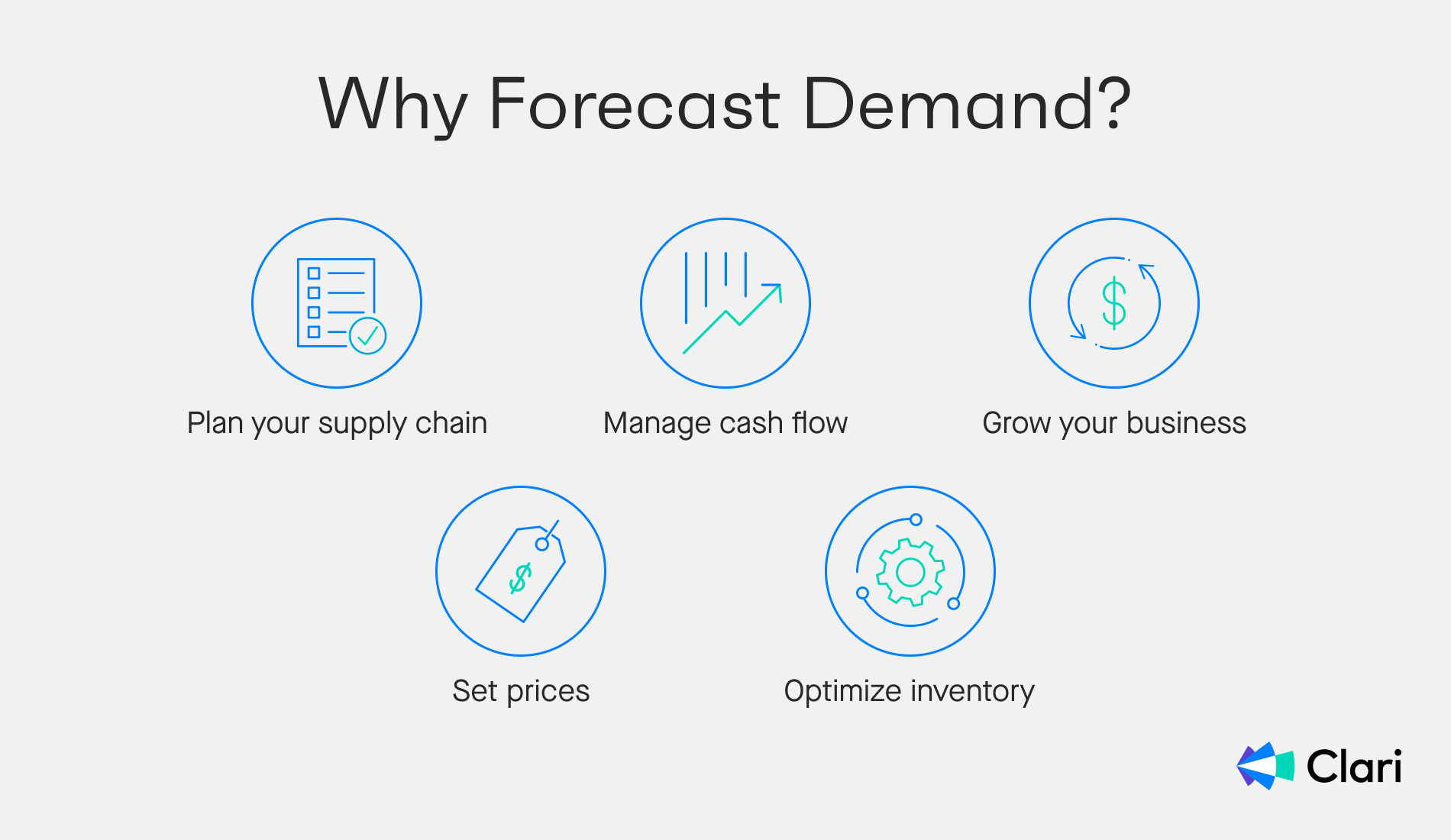
Plan your supply chain
There are a lot of moving parts to your supply chain. And you can optimize most of them using a demand forecast.
For example, do you need to find more suppliers to fill demand? Do you need expedited shipping? Or can you save money by adopting a slow shipping schedule? These are all questions that can be answered using demand forecasting.
Manage cash flow
Knowing how many products you expect to sell and how much revenue you will generate makes it easier to manage your cash and budget accordingly.
Take the example of over-ordering inventory because of a poor forecast. When you invest too much in inventory, you have less cash to spend on marketing and other growth opportunities.
Grow your business
It's hard to know how fast to grow your business. Scale too slowly, and you risk losing customers for failing to meet their demands. Move too quickly, however, and you could burn through cash and inventory before you can break even.
Accurate demand forecasts can help you strike the right balance and ensure you make data-backed decisions.
Set prices
You can price accordingly when you know how many products you will sell. If you think you're going to experience a surge in demand, you can raise prices, just like Uber did with Surge pricing.
Or if you think demand will fall, you can lower prices to encourage more sales and drive more revenue in the short term.
You can also forecast how demand will change depending on your pricing. Will higher prices scare off customers? Or can you get away with raising prices without reducing demand? A demand forecast can answer those questions, too.
Optimize inventory
Not having enough inventory to fulfill customer demand is a nightmare. It's a recipe for lost revenue and unhappy customers.
Having too much inventory can be just as bad. It could mean paying for an additional warehouse or ending up with obsolete inventory.
But with a good demand forecast, you can optimize your inventory and order the right product—give or take—to meet customer demand.
Six demand forecasting methods
There are six main demand forecasting models. You may prefer one over the others, but it's good practice to use several methods when forecasting demand.
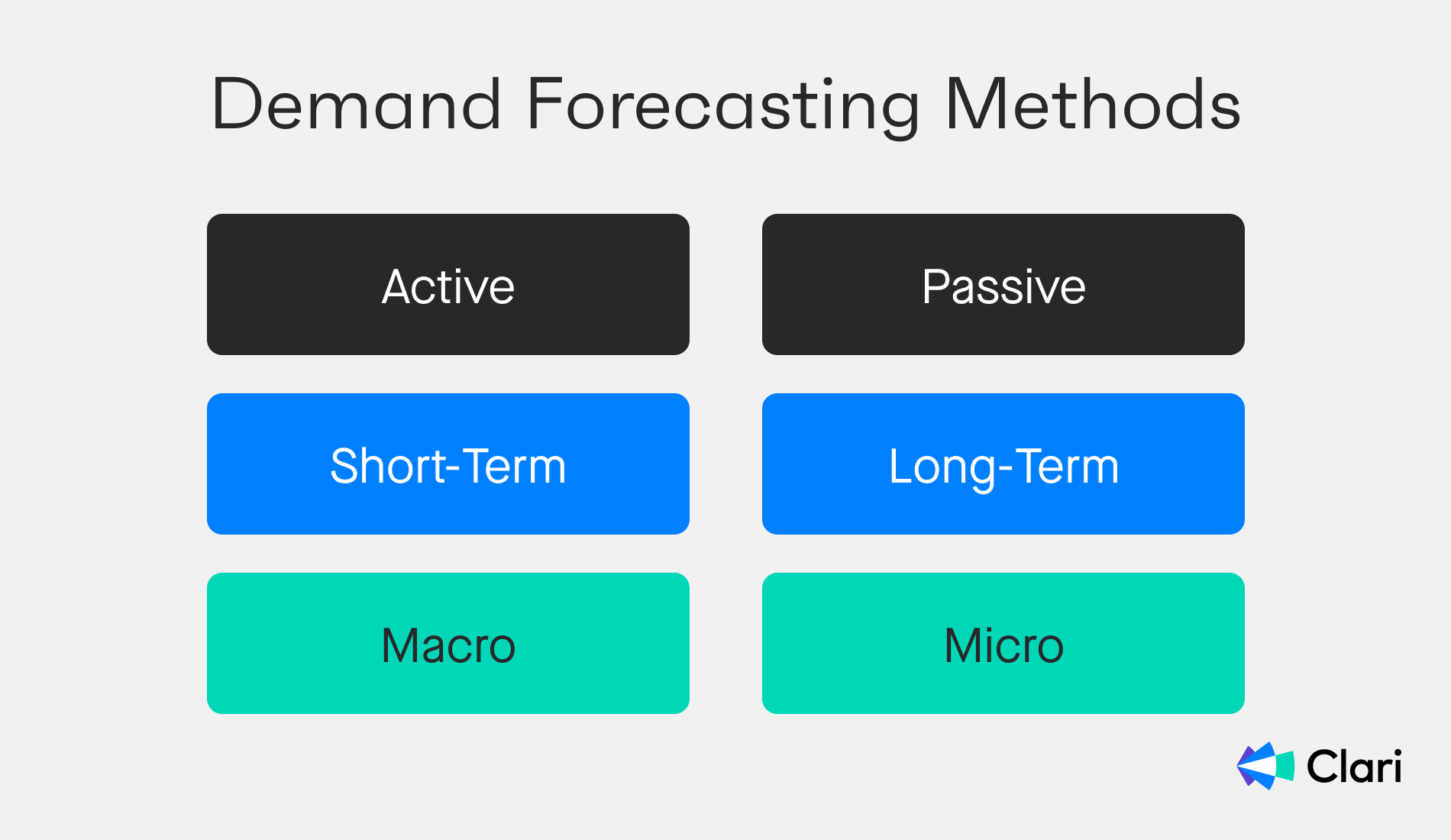
Active demand forecasting
When forecasting future demand, active demand forecasting considers your business' activities (hence the name). That includes things like marketing campaigns, expansion plans, and market research.
It's a great forecasting method for any business experiencing growth. It takes into account your efforts, and it also considers external factors like the economy and consumer trends. It's a particularly good option for fast-growing startups that don't have a huge amount of sales data to use.
Passive demand forecasting
Passive demand forecasting is arguably the simplest and easiest way to predict future demand. It's largely a set-it-and-forget-it approach to forecasting demand where companies rely on historical data (product sales, consumer trends, seasonality, etc.) that is expected to remain relevant.
There's no statistical method or complex analysis with passive demand forecasting, so practically anyone can get started. Just make sure you are using accurate and relevant historical data. In other words, you aren't using Q1 sales from five years ago to predict this year's Q3 sales.
It's an effective option for established companies in mature markets. But it's not going to work for the startup building a market of its own or a company looking to disrupt existing markets with a brand-new product.
Short-term demand forecasting
Short-term demand forecasting is a prediction of the near future. That means the next month, quarter, or year.
There's no reason you can't make even more short-term predictions if you like. Why not forecast demand for the upcoming weekend or next week based on last week's sales?
These forecasts tend to be pretty accurate since they use real-time data and are unlikely to get thrown off by unexpected external events. This makes them ideal for adjusting your supply chain and optimizing inventory.
Short-term forecasts are particularly important for businesses that change products or inventory regularly—like grocery stores that stock seasonal produce.
Long-term demand forecasting
A long-term demand forecast makes predictions one to five years into the future. These demands tend to be strategic, helping companies assess what might occur in the future if a set of assumptions plays out.
These forecasts are not as accurate as short-term demand forecasts, but that doesn't matter much. After all, companies aren't using these to make short-term revenue-based decisions that could bankrupt the company if they are wrong. They use them to consider whether an expansion, acquisition, or move is a good idea.
Macro demand forecasting
Macro demand forecasting looks at wide (and usually external) trends and how they impact demand. This can include economic conditions and consumer trends that can be risks or opportunities.
Macro demand forecasts are pretty expansive, usually undertaken by well-established companies that want to protect their place in the market and plan for the future.
Micro demand forecasting
Micro demand forecasts use a company's internal sales and customer behavior data to predict future demand. These are much more specific than macro forecasts, usually looking at a specific product or region.
Plenty more demand forecast methods don't fit neatly into these six boxes. If you'd like to learn more about them, download our definitive guide to forecasting methods and discover the one that is right for you.
Demand forecasting techniques
Once you have a demand forecasting method in mind, you can use several different techniques to create it. These include:
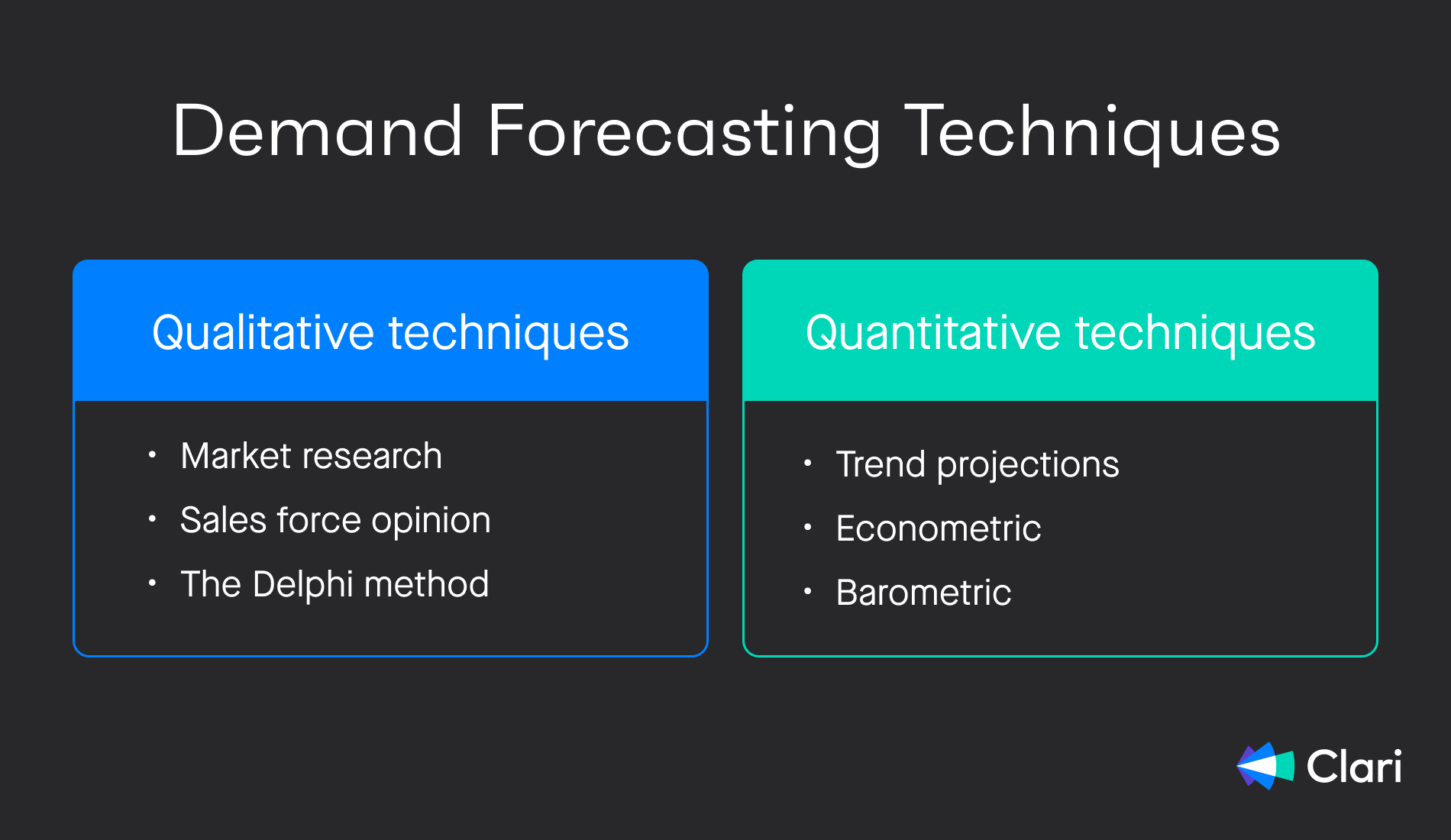
Market research
Market research will be familiar to most people. You may even have taken part in it. Whether in the form of surveys or focus groups, it is a great way to gather information relatively straightforwardly.
Market research allows firms to gather the kind of qualitative data you can't get from sales figures. It's a chance to understand your customers' thoughts, identify their needs, and spot potential opportunities.
You don't even need to run this kind of research in person. Online tools like SurveyMonkey make it easy to conduct research online.
Sales force opinion
Your sales team has its finger on the market's pulse, so who better to ask for a prediction on demand? A salesforce opinion forecast does just that—getting the collective opinion of your sales team.
The depth and quality of your data will depend on the size of your team. Naturally, the larger the better. Multinational companies will be able to get a global angle on the future of demand, but you could also break predictions down by country, industry, or even local markets.
Refining this method over time is quite easy (and often necessary). You'll soon realize which salespeople make somewhat accurate predictions and which reps are completely off the mark.
The Delphi method
The Delphi method is a macro forecasting technique that relies on qualitative data from a panel of experts that gets refined over time.
Here's how it works: the experts independently work on a set of questions. You create a summary of the responses and share it with your panel of experts anonymously. You keep repairing this process, with each summary informing the next round of discussions.
The Delphi method is a great way to get the opinions of experts worldwide since they never have to sit in the same room. It also ensures you get an unbiased overall opinion greater than the sum of each individual's opinion.
Trend projections
A trend projection is a quantitative technique that uses regression analysis to predict future outcomes based on historical data. This is the simplest quantitative technique you can use.
This technique can be more accurate by adding context to historical data and accounting for anomalies. Any business using sales made during the pandemic will need to do this, for instance, if they want accurate results.
Econometric
Econometrics is a more advanced form of regression modeling that analyzes sales data with external data to predict demand.
It's certainly more intensive than other methods and requires complex statistical formulas. But it can lead to much more precise forecasts.
Barometric
Barometric forecasts use leading and lagging indicators and coincidental indicators to forecast trends.
Leading indicators attempt to predict future events using the data at hand. Lagging indicators look back at historical data. Coincident indicators look at the present, using real-time data to reflect the present situation.
Demand forecasting examples
Here are some examples of how you can combine the previous methods and techniques to create a forecast:
Forecasting Black Friday and Cyber Monday demand
An electronics retailer wants to know how many products they are likely to sell this holiday season to ensure they have the right stock levels. They have a decade's sales data, so they are in a great position to run a passive demand forecast.
However, the store has been buffeted by external factors since the start of the year. The economy has been sluggish, and a competing retailer recently opened a store there.
As such, the store may need to temper its demand forecast since previous performance may not accurately indicate future demand in this case.
To be sure, the store could invest in market research to understand consumer attitudes to holiday shopping this year and whether a poor economy will prevent them from making purchases or encourage them to go out and look for deals.
Forecasting demand for a fast-growing startup
A young and fast-growing startup wants to understand how many software subscriptions they can expect to sell in the next quarter. The only problem is they don't have a lot of sales data to fall back on, and their product is fairly disruptive, making it hard to use historical data from other companies to predict demand.
The solution is to use a short-term salesforce opinion forecast. The sales team has their fingers on the pulse of the industry better than anyone else and can use the data in their pipeline and the qualitative information they get from prospects to predict demand.
Forecasting demand for air travel
An airline wanted to understand how the demand for air travel may change in five to ten years. They could run a long-term macro demand forecast to understand how customer habits may change due to climate change and other factors.
In this case, there may not be a huge amount of data to go off, which is why using a technique like the Delphi method is suitable. By getting the opinions of experts, they can understand which actions they could take today to keep demand high—whether that's investing in R&D into new biofuels, investing in more sustainable aircraft, or launching a marketing campaign.
Factors influencing demand forecasting
There are a host of internal and external factors that can influence your demand forecast. These can be one-off events, like an economic recession, or recurring events like seasonality.
Here are six of the most important factors to be aware of:
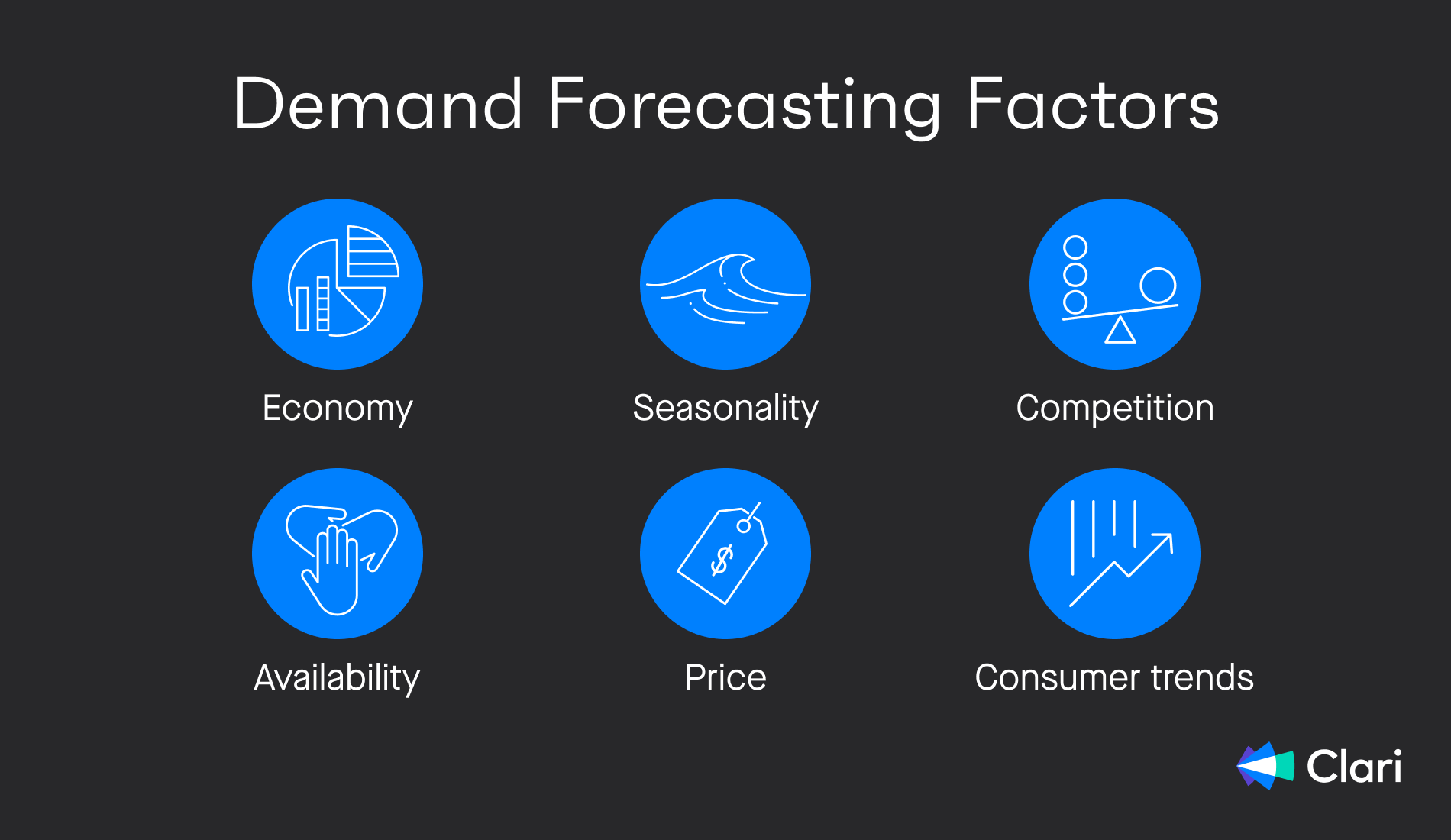
Economy
You can't control the economy, and, unfortunately, it can greatly impact demand. Economic conditions like a recession, high inflation, or even a global pandemic can cause major fluctuations in consumer confidence.
Economic conditions can work globally—like the pandemic, for instance. But it can also work on a localized geographical level. Economic conditions in a country you sell into or manufacture in can impact demand.
Seasonality
Seasonality is the change in demand for a product over a year. Some products, like sunscreen, have very obvious seasonal trends. Others can be more subtle or exacerbated by unexpected weather events.
Most businesses will have some seasonal products. But, in some cases, entire businesses will be seasonal.
Understanding seasonal demand is essential to optimize inventory. Businesses must know when to slow purchase orders ahead of a quiet period to reduce costs.
Competition
Competition has a direct impact on demand. In theory, the more options your customers have, the fewer products you will sell. But the opposite is also true. If one of your competitors shuts up shop, your demand could increase.
Your competition isn't always predictable. Competitors can come out of the blue and throw off your demand forecasts. That's why it's important to forecast regularly.
Availability
Availability can impact demand. Just ask anyone trying to buy toilet paper during the pandemic. If customers think that supply is short, demand could increase substantially.
It doesn't matter if availability is artificially or authentically limited—demand will probably still increase. It's why limited-time offers work so well.
Price
Price is one of the major factors that impact demand. A high school economics student can tell you that lower prices will result in more demand, everything else being equal.
Price is both an internal and external factor. On the one hand, you can lower your prices to increase demand. At the same time, however, your competitors could be doing the same thing.
Consumer trends
Consumer trends are constantly changing and can have a significant impact on demand.
There's no shortage of “hot” products for a period. Just ask the manufacturers of fidget spinners, PopSockets, and yo-yos. One day, orders were piling in. The next day, demand disappeared.
You can impact consumer trends to some degree through marketing and advertising. Still, you'll always be somewhat at the whim of customers who change their opinions or governments who want to encourage other habits.
Demand forecasting in 5 Steps
Ready to create your first demand forecast? Follow the steps below:
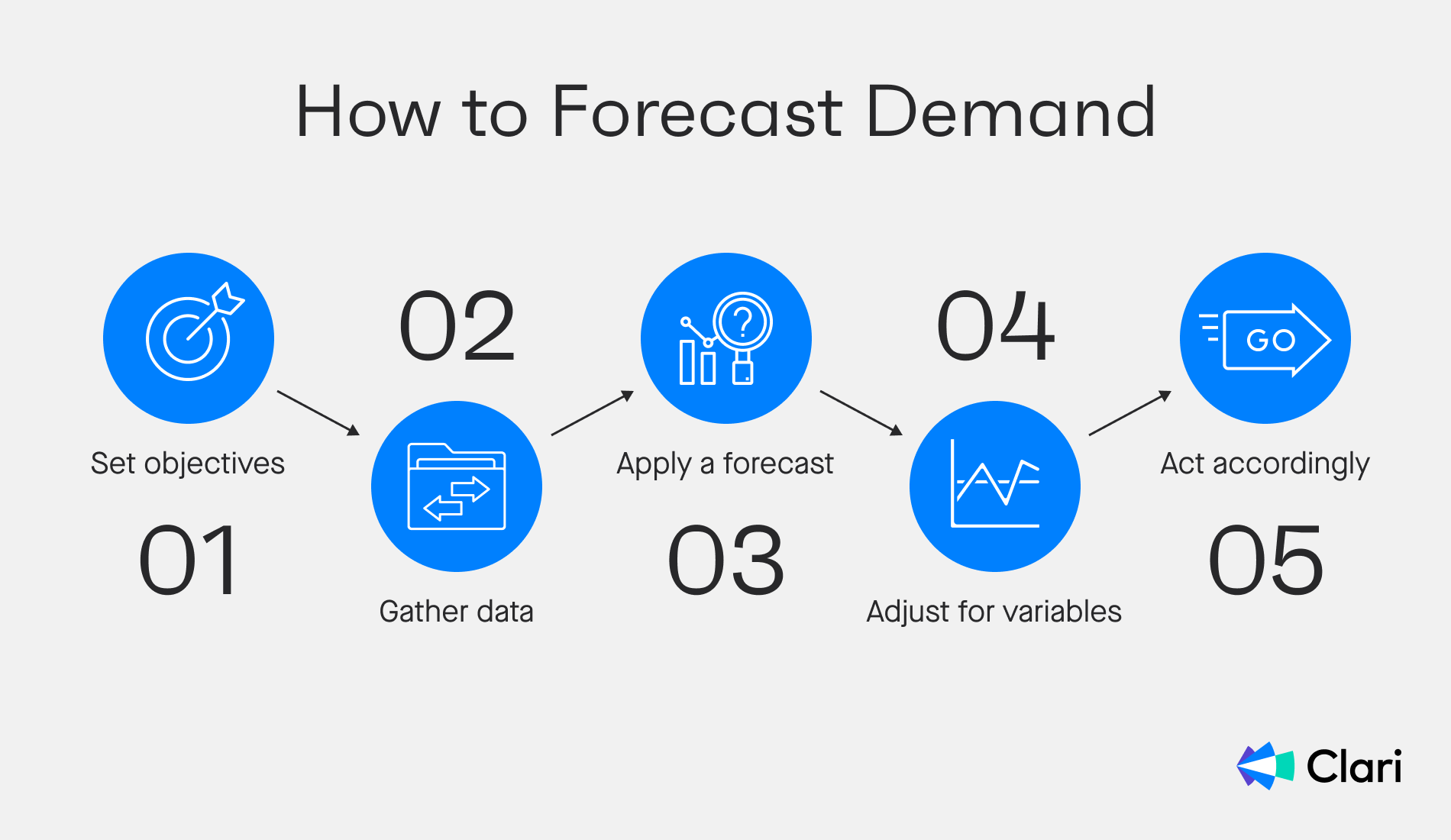
Set objectives
The first step when creating any kind of demand forecast is to identify the forecast's goals.
What are you looking to achieve with it? What's the timeframe? How specific does it need to be? Is it forecasting demand for a single product or your company's entire offering? These are the kinds of questions you need to answer.
Be clear about why you want to run a demand forecast. How will it help your business? What do you want to achieve?
Gather data
Next, you need to assess the current and any other data you can access.
For instance, you might have a mountain of data inside your ERP system. That's great. But can you supplement that with the opinions of experts or team members? Can you generate qualitative data as well as quantitative data?
Don't forget about third-party data like market trends and economic outlooks.
Apply a forecast and analyze the data
Once you've got the data, you can apply one of the above-mentioned methods and techniques. Hopefully, we've given you a clear idea of which methods suit various situations.
Don't be afraid to go back and gather more data once you have decided on a forecasting method. There's no such thing as having too much data—as long as it's good quality.
Consider using a forecasting tool, too.
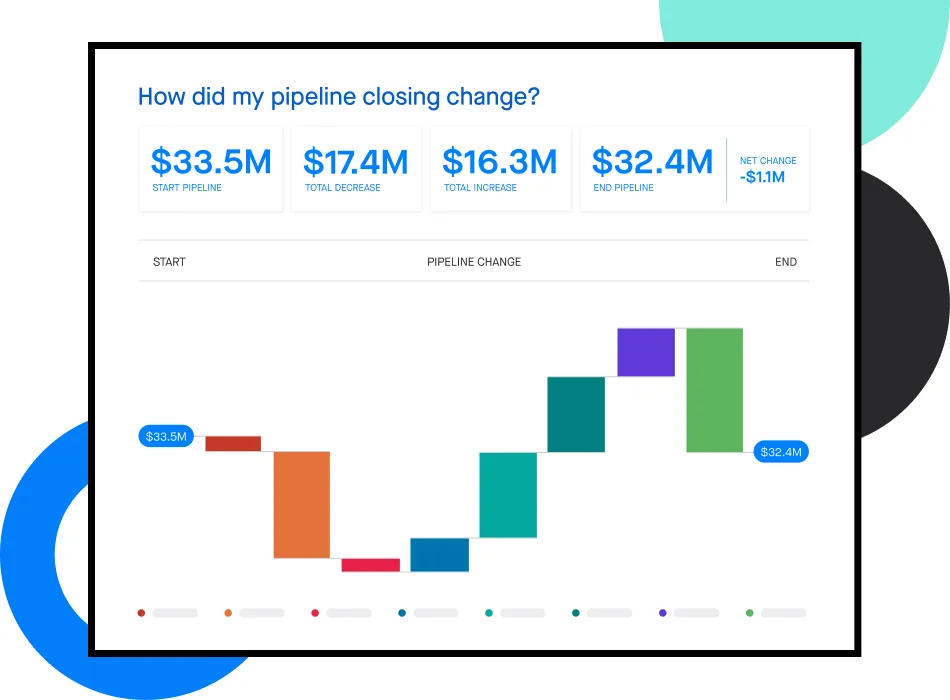
Take Clari's revenue platform, for instance. It automatically gathers and centralizes quantitative data in the background by integrating with your business' tool stack. Analytics and dashboards allow you to see past sales performance at a glance and then use that data to build a demand-based forecast for the future.
Adjust for variables
If you've read this far, you'll know tons of mitigating factors can impact your forecast's accuracy. This is your chance to account for them.
Is consumer opinion changing, for instance? Perhaps there is uncertainty in the economy that could suppress demand. Use the research you've gathered to adjust your model accordingly.
Take the time to add context to your demand forecast at this stage, too. Tell readers why you expect demand to rise or fall to this extent. Make an observation on how accurate you think the forecast is and what, if anything, may cause it to change in the future.
Remember, not everyone who reads your report will be au fait with the models and methods you've used. Adding this additional detail makes your forecasts as actionable as possible.
Act accordingly
The final step of the process is to put your demand forecast to use. After all, what's the point of creating a demand forecast if you aren't going to use it?
Make sure you are tracking the accuracy of your forecasts, too. Assess to what extent you over- or under-forecast demand and what went wrong. The more you learn from your mistakes, the more accurate your future forecasts will be.
What's next?
Predicting demand for your company's products is essential to managing cash flow, optimizing inventory, and growing revenue.
There is no shortage of methods and techniques you can use to predict future demand, from short-term quantitative approaches or long-term qualitative approaches. Regardless of which method you favor, you can and should use several.
But forecasting takes time. That's why smart teams use digital tools to automate and accelerate forecasting.
Find out how Clari can help your team forecast demand by taking a product tour or improving your forecasting technique using our comprehensive checklist.


